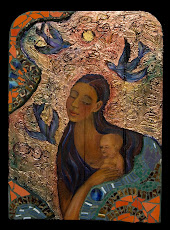I read your article on artisan breads using a natural yeast starter. I have made breads for a long time using the Active Dry yeast and I am trying to make a starter, but it seems to die every couple weeks. I use the Fleischmann's Active Dry to make the starter and it seems to be okay for the first 3 or 4 times I bake. Near the end it starts to leaven sluggishly. By the 5th or 6th loaf, it doesn't leaven at all. What I do is I have about 2 cups of it total in the fridge. When I want to use it I take it out of the fridge and leave it for ~12 hours. I use 1 cup in my bread and I save 1 cup to continue the starter. I add 3/4 c distilled water + 3/4 c flour to the starter and shake it and loosely cover it. 4 hours later, I put it back in the fridge. Then I leave it for a week, until the next weekend. Is there something that is wrong w/ my methods? Your starter looks so successful; I don't know what is going on.
Thanks, Gillian
Hi Gillian,

I think the problem stems from your sourdough starter being created predominantly with a hybrid commercial yeast. For example, in nature (without the intervention of humankind) I've never seen a forest of all one kind of tree. The healthy forest of centuries old contains a variety of plants and animals that live harmoniously (or more specifically, symbiotically) together. Your commercial starter is in a sense, a Christmas tree farm compared to the old growth forest of a natural starter often referred to as Sourdough or Pain Levain.
Here's a line from Wikipedia that gives a little insight into your challenge. The text within parenthesis is mine. "The flour-water mixture can also be inoculated from a previously maintained culture. (A natural sourdough or levain culture that you buy or get from a baker.) The culture is stable due to its ability to prevent colonization by other yeasts and bacteria as a result of its acidity and other anti-bacterial agents. As a result, many sourdough bread varieties tend to be relatively resistant to spoilage and mold.
Because you begun with a commercial starter it does not include a natural relationship between a yeast and lactobacillus thus, it does not have the resilience and stability of a natural yeast starter. Since you're obviously excited about the process of making artisan bread, either find a home baker willing to give you some starter, or buy sourdough starter from King Arthur Flour company or other type of reputable baking supply company.
It's a simple process to rejuvenate the starter and then to make the bread, though by the length of the artisan sourdough bread recipe on my website, it looks a lot more complicated! I had to make a detailed yeast bread recipe that explained the concepts behind the choices of ingredients and techniques. Artisan natural yeast bread baking is actually far more simple than it is presented to be. Think about it, for centuries most bread was made by a village specialist or by the homemaker. These people did not usually have the resources to use high-tech measurements and temperature readings, and most people were illiterate then. They told time by the sun and had few dishes, yet the bread could be masterful.
A book I've enjoyed about the history of sourdough is World Sourdough's From Antiquity, by Ed Wood details his story as a botanist who did a project for National Geographic where he investigated the natural yeast baking process that the Egyptians used to feed the workers who built the pyramids.
So . . . have fun with a natural yeast bread starter and let me know how it's working. Send me a photo of you with your bread loaves.
Read more about my ideas for varying your bread recipe including making Chocolate Bread and more. Check out my list of recipes for everything from my favorite Key Lime Squares to the perfect mexican salsa recipes on my website.
www.CristinaAcosta.com

















No comments:
Post a Comment